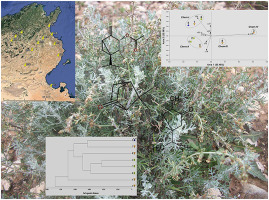当前位置:
X-MOL 学术
›
Phytochemistry
›
论文详情
Our official English website, www.x-mol.net, welcomes your feedback! (Note: you will need to create a separate account there.)
Relationship between chemotypic and genetic diversity of natural populations of Artemisia herba-alba Asso growing wild in Tunisia
Phytochemistry ( IF 3.8 ) Pub Date : 2018-04-01 , DOI: 10.1016/j.phytochem.2018.01.014 Faten Younsi , Najoua Rahali , Sameh Mehdi , Mohamed Boussaid , Chokri Messaoud
Phytochemistry ( IF 3.8 ) Pub Date : 2018-04-01 , DOI: 10.1016/j.phytochem.2018.01.014 Faten Younsi , Najoua Rahali , Sameh Mehdi , Mohamed Boussaid , Chokri Messaoud

|
A total of 80 individuals collected from eight populations growing wild in different geographic zones were considered to assess the intraspecific variability of essential oil composition, genetic diversity and population structure of Artemisia herba-alba. The essential oil composition varied significantly between populations. Essential oil profiles were classified into four chemotypes (trans-sabinyl acetate, α-thujone/trans-sabinyl acetate, camphor and α-thujone/camphor/β-thujone). Despite significant correlation between the amount of some essential oil compounds and a set of climatic data, the global chemical divergence among populations was not related to their bioclimatic and geographic appurtenances. A high level of genetic diversity within populations was revealed either with RAPD and ISSR markers (Na = 1.67, PPL = 66.5%, H = 0.26, I = 0.38 and Na = 1.7, PPL = 69.8%, H = 0.26, I = 0.38, respectively). The level of genetic diversity varied across populations and chemotypes. Populations from the α-thujone/trans-sabinyl acetate chemotype exhibited the highest genetic diversity as revealed by the RAPD markers. However, populations from α-thujone/camphor/β-thujone chemotype showed the important genetic variation determined by ISSR markers. A significant genetic differentiation among populations and among chemotypes was detected. The combined analysis showed a significant correlation (r = 0.484, p = .032) between the chemical and molecular markers. The PCA, performed on percentages of major oil compounds and the frequencies of polymorphic RAPD and ISSR bands, divided populations according to their chemotypic classification. Taking into consideration the current situation of A. herba-alba populations and their endangered habitats, these results are of value in order to ensure the in-situ and ex-situ conservation of this medicinal species.
中文翻译:

突尼斯野生白蒿自然种群化学型与遗传多样性的关系
从不同地理区域的 8 个野生种群中收集的总共 80 个个体被认为是评估白蒿精油成分、遗传多样性和种群结构的种内变异性。不同人群的精油成分差异很大。精油谱被分为四种化学类型(反式-sabinyl 醋酸、α-thujone/trans-sabinyl 醋酸、樟脑和α-thujone/樟脑/β-thujone)。尽管某些精油化合物的数量与一组气候数据之间存在显着相关性,但人群之间的全球化学差异与其生物气候和地理附属物无关。使用 RAPD 和 ISSR 标记(Na = 1.67,PPL = 66.5%,H = 0.26,I = 0. 38 和 Na = 1.7,PPL = 69.8%,H = 0.26,I = 0.38)。遗传多样性水平因种群和化学型而异。正如 RAPD 标记所揭示的那样,来自 α-thujone/反式醋酸沙宾酯化学型的种群表现出最高的遗传多样性。然而,来自 α-thujone/樟脑/β-thujone 化学型的种群显示出由 ISSR 标记确定的重要遗传变异。检测到种群之间和化学型之间的显着遗传差异。综合分析显示化学和分子标记之间存在显着相关性 (r = 0.484, p = .032)。PCA 对主要油化合物的百分比和多态性 RAPD 和 ISSR 带的频率进行,根据其化学型分类对种群进行划分。考虑到 A.
更新日期:2018-04-01
中文翻译:

突尼斯野生白蒿自然种群化学型与遗传多样性的关系
从不同地理区域的 8 个野生种群中收集的总共 80 个个体被认为是评估白蒿精油成分、遗传多样性和种群结构的种内变异性。不同人群的精油成分差异很大。精油谱被分为四种化学类型(反式-sabinyl 醋酸、α-thujone/trans-sabinyl 醋酸、樟脑和α-thujone/樟脑/β-thujone)。尽管某些精油化合物的数量与一组气候数据之间存在显着相关性,但人群之间的全球化学差异与其生物气候和地理附属物无关。使用 RAPD 和 ISSR 标记(Na = 1.67,PPL = 66.5%,H = 0.26,I = 0. 38 和 Na = 1.7,PPL = 69.8%,H = 0.26,I = 0.38)。遗传多样性水平因种群和化学型而异。正如 RAPD 标记所揭示的那样,来自 α-thujone/反式醋酸沙宾酯化学型的种群表现出最高的遗传多样性。然而,来自 α-thujone/樟脑/β-thujone 化学型的种群显示出由 ISSR 标记确定的重要遗传变异。检测到种群之间和化学型之间的显着遗传差异。综合分析显示化学和分子标记之间存在显着相关性 (r = 0.484, p = .032)。PCA 对主要油化合物的百分比和多态性 RAPD 和 ISSR 带的频率进行,根据其化学型分类对种群进行划分。考虑到 A.



























 京公网安备 11010802027423号
京公网安备 11010802027423号